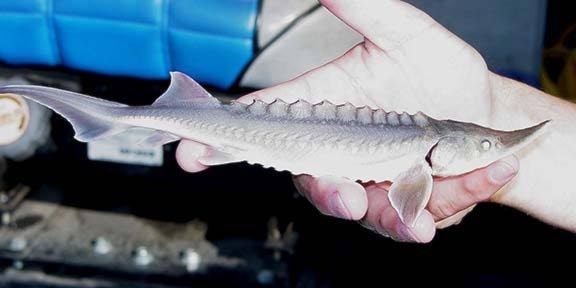Scientists are still holding out hope for the endangered Kootenay white sturgeon after a three-year U.S. experiment failed to draw the fish upstream to where they could successfully spawn.
The largest freshwater fish in North America, white sturgeon can grow to 12 feet in length and weigh up to 1,000 pounds in their 100-year life span.
With an estimated 1,000 wild adult fish remaining, the Kootenay white sturgeon was listed as endangered in Canada in 2003, after nine years on the U.S. endangered list.
Wild sturgeon are found in Montana, Idaho and B.C. and they spawn downstream of Montana's Kootenai Falls and the Libby, Montana dam on Koocanusa reservoir.
The fish, which don't begin reproducing until about age 30, have been in decline since the 1950s.
"Although they were potentially declining in the late '50s and early '60s, they were still reproducing, they just weren't producing as large a year class. The last year class produced naturally was in 1974," said Jason Flory, fish and wildlife biologist with the U.S. Fish and Wildlife Service in Spokane, Washington.
In 2008, biologists began spilling up to 35,000 cubic feet of water from Libby Dam into the Kootenay River each spring, timed to coincide with the sturgeon’s urge to spawn.
The idea was to mimic the spring freshet the sturgeon experienced before construction of the dam began in 1965 under the Columbia River Treaty.
“The intent was to coax the sturgeon to migrate upstream to spawn,” said Flory.
After three years of spill tests, including two with naturally high spring freshets, Flory said, “it doesn’t look like we achieved the intended results.”
Instead of spawning upstream of Bonners Ferry in a cobble and gravel-bottomed stretch of the river, which is believed to be the most suitable, the sturgeon are still primarily spawning with little success in silt-filled gravel downstream of Bonners Ferry.
“The sturgeon are spawning; it’s just getting them to spawn in the right spots,” said Flory.
Biologists will continue their work to encourage the sturgeon to reproduce naturally, he went on, although the next step hasn’t yet been determined.
“We haven’t figured that out yet,” said Flory. “We are working with our other partners and we are going to sit down and figure out what to do. We still have the volume of sturgeon water that we work with every year.”
He added that they have not yet decided whether to continue spilling water from the dam each spring.
But the white sturgeon still have a future, thanks to a hatchery in Bonners Ferry, operated by the Kootenai Tribe of Idaho.
Since 1991, the hatchery has produced about 200,000 white sturgeon which are then released into the Kootenay River downstream of Bonners Ferry.
Each year, some of those young fish are released into Kootenay Lake in the West Kootenay.
In 2012, approximately 2,300 juvenile sturgeon were released in a special event in Creston, attended by First Nations members and elders, as well as members of the public.
Kootenay white sturgeon are important both culturally and for sustenance to the Ktunaxa Nation.
Last December, the Kootenai Tribe was given the green light to expand the existing Bonners Ferry hatchery, and build a new hatchery about 16 kilometres upstream where the Kootenay River and Moyie River meet.
“The next generation of sturgeon will be entirely from the hatchery,” said Sue Ireland, director of the Kootenai Tribe of Idaho’s Fish and Wildlife Program.
Each year since 1998, some fertilized sturgeon eggs spawned in Idaho are brought to the Kootenay Trout Hatchery near Fort Steele.
They are cultured there for about a year before being released into Kootenay Lake.
Thanks to the hatcheries’ work, Flory said there is still hope for the Kootenay white sturgeon.
“We do have the hatchery program, which is always going to provide the next generation of fish. We also have some habitat restoration work that the tribe is implementing. Those are targeted towards providing better spawning conditions for the sturgeon. And we still have some things we can try with the flows, to see if they work. So we are still hopeful,” he said.
